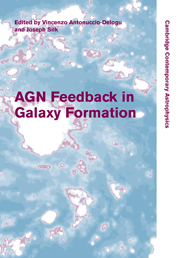Book contents
- Frontmatter
- Contents
- List of contributors
- Preface
- The organising committees
- Part I AGNs, starbursts and galaxy evolution
- Part II Co-evolution of black holes and galaxies
- Part III Outflows and radio galaxies
- Part IV Models and numerical simulations: methods and results
- 12 Physical models of AGN feedback
- 13 Large-scale expansion of AGN outflows in a cosmological volume
- 14 Relativistic jets and the inhomogeneous interstellar medium
- 15 AGN feedback effect on intracluster medium properties from galaxy cluster hydrodynamical simulations
- 16 Physics and fate of jet-related emission line regions
- 17 Cusp–core dichotomy of elliptical galaxies: the role of thermal evaporation
- Index
16 - Physics and fate of jet-related emission line regions
from Part IV - Models and numerical simulations: methods and results
Published online by Cambridge University Press: 10 November 2010
- Frontmatter
- Contents
- List of contributors
- Preface
- The organising committees
- Part I AGNs, starbursts and galaxy evolution
- Part II Co-evolution of black holes and galaxies
- Part III Outflows and radio galaxies
- Part IV Models and numerical simulations: methods and results
- 12 Physical models of AGN feedback
- 13 Large-scale expansion of AGN outflows in a cosmological volume
- 14 Relativistic jets and the inhomogeneous interstellar medium
- 15 AGN feedback effect on intracluster medium properties from galaxy cluster hydrodynamical simulations
- 16 Physics and fate of jet-related emission line regions
- 17 Cusp–core dichotomy of elliptical galaxies: the role of thermal evaporation
- Index
Summary
Introduction
At redshifts above z ≳ 0.5 extragalactic jet sources are commonly associated with extended emission line regions (for a review see McCarthy 1993; Miley and De Breuck 2008). The most prominent emission line is the hydrogen Lyman α line, but other typical nebular emission lines have also been found. These regions are up to 100 kpc in extent, anisotropic and preferentially aligned with the radio jets (alignment effect). Their properties correlate with those of the radio jets: smaller radio jets (< 100 kpc) have more extended emission line regions with larger velocity widths (1000 km s−1) that are predominantly shock ionised, as diagnosed from their emission line ratios. Larger radio jets (> 100 kpc) have emission line regions even smaller than 100 kpc. Their turbulent velocities are typically about 500 km s−1 and the dominant excitation mechanism is photoionisation. The physical function of these emission line regions can be compared to a detector in a particle physics experiment: in both cases a beam of high-energy particles hits a target. Analysis of the interactions in the surrounding detector, or in astrophysics the emission line gas, provides information about the physical processes of interest. For the astrophysical jets, the information one would like to obtain from such analysis concerns two traditionally separate branches of astrophysics.
The considerable energy release that may be associated with the jet phenomenon is received by a large reservoir of gas surrounding the host galaxy.
- Type
- Chapter
- Information
- AGN Feedback in Galaxy Formation , pp. 183 - 193Publisher: Cambridge University PressPrint publication year: 2010
- 4
- Cited by

